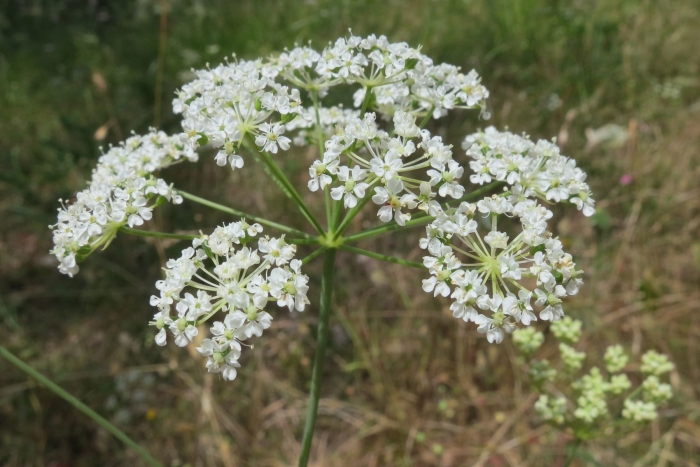Oregon Yampah
(Perideridia oregana)
Oregon Yampah (Perideridia oregana)
/
/

Ed Alverson
CC BY 4.0
Image By:
Ed Alverson
Recorded By:
Copyright:
CC BY 4.0
Copyright Notice:
Photo by: Ed Alverson | License Type: CC BY 4.0 | License URL: http://creativecommons.org/licenses/by/4.0/ | Rights Holder: Ed Alverson | Publisher: iNaturalist | Date Created: 2019-06-30T14:28:07-07:00 |











Estimated Native Range
Summary
Perideridia oregana, commonly known as Oregon yampah or eppaw, is a perennial herb native to the Pacific Northwest, specifically to moist meadows, grasslands, and open woodlands in Oregon and California. It can grow up to 35 inches tall and features green to waxy-gray stems with compound leaves that are finely divided and fern-like in appearance. The plant produces a compound umbel of small, showy white flowers during the summer months, which are followed by ribbed, oblong-shaped fruits that are of interest to various wildlife species.
Oregon yampah is valued for its low maintenance and adaptability to various soil types, though it prefers moist, well-drained soils. It thrives in full sun to part shade conditions and is often used in native plant gardens, restoration projects, and as a component in pollinator-friendly landscapes due to its attractive flowers and ability to support beneficial insects. While not commonly used in culinary applications today, the tuberous roots of Oregon yampah were historically consumed by indigenous peoples and are edible. Gardeners should note that this species may not be suitable for small garden spaces as it can spread via seeds and underground stems, potentially becoming aggressive in favorable conditions.CC BY-SA 4.0
Oregon yampah is valued for its low maintenance and adaptability to various soil types, though it prefers moist, well-drained soils. It thrives in full sun to part shade conditions and is often used in native plant gardens, restoration projects, and as a component in pollinator-friendly landscapes due to its attractive flowers and ability to support beneficial insects. While not commonly used in culinary applications today, the tuberous roots of Oregon yampah were historically consumed by indigenous peoples and are edible. Gardeners should note that this species may not be suitable for small garden spaces as it can spread via seeds and underground stems, potentially becoming aggressive in favorable conditions.CC BY-SA 4.0
Plant Description
- Plant Type: Herb
- Height: 1-2 feet
- Width: 0.5-1 feet
- Growth Rate: Moderate
- Flower Color: White
- Flowering Season: Summer, Fall
- Leaf Retention: Deciduous
Growth Requirements
- Sun: Full Sun, Part Shade
- Water: Medium
- Drainage: Medium
Common Uses
Bee Garden, Edible*Disclaimer: Easyscape's listed plant edibility is for informational use. Always verify the safety and proper identification of any plant before consumption., Low Maintenance
Natural Habitat
Moist meadows, grasslands, and open woodlands in Oregon and California
Other Names
Common Names: Squaw Potato, Squawroot
Scientific Names: , Perideridia oregana, Atenia oregana, Carum oreganum, Edosmia oregana,
GBIF Accepted Name: